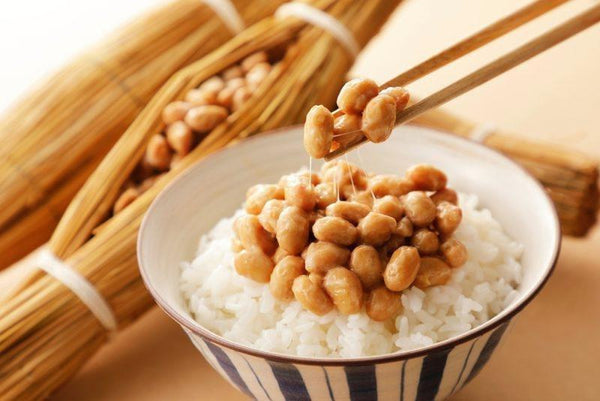
Jump to:
Natto is without a doubt one of the most controversial Japanese foods out there. If you’re familiar with it, then you know that the lovers and haters of natto are as clearly divided as can be.
In fact, it seems nearly impossible to be neutral or even partial to the taste or texture of natto. But, why does natto have such a controversial reputation? What are the benefits of eating natto? Why does this beloved Japanese superfood have such a bad rep overseas?
In this article, we’re going to go over the basics of natto, such as its taste, how it’s made, and more. We’ll also share our top favorite natto products that are available for purchase online.
If you’ve ever been on the fence about trying natto, we hope to give you a clearer sense of what to expect when eating it. Hopefully after reading this article, you’ll be able to decide whether you want to take the leap of faith and try it out for yourself.
What is Japanese Natto?

What even is natto to begin with? Natto is made of fermented soybeans infamous for their sticky, slimy texture, brown color, and pungent odor. While that description may not sound very appealing, natto is a beloved food in Japan that is consumed daily by many Japanese. Yes, natto may have an acquired taste, but it is packed with many nutrients and health benefits, which is why it is such a staple food in Japan. Not to mention, many people find natto to be delicious!
What Does Natto Taste Like?

Even though natto is a fermented food, it does not have a sour flavor. In fact, these fermented soybeans are slightly bitter on their own and actually do not taste as strong as they smell. Natto could also be described as having an earthy flavor, but in fact, they don’t have much flavor on their own.
Since natto is relatively mild in flavor, a soy-based seasoning packet and karashi (Japanese mustard) packet are usually sold with it. These seasonings give natto an umami, slightly sweet, and spicy flavor. While these two seasonings are most commonly sold with natto, in Japanese supermarkets, many other seasoning varieties are sold alongside natto including ponzu, umeboshi, and even an egg-based soy sauce.
How To Eat Natto, The Traditional Way

Natto is usually enjoyed over a bowl of hot steamed rice for breakfast. All you have to do to enjoy natto this way is mix the natto beans and included seasoning packets together until the natto becomes super slimy and sticky. Pour over a bowl of rice, top with chopped green onions if you like, and done. Adding other toppings such as kimchi, nori, or even avocado will make your morning natto-rice bowl even more delicious.
If you’re feeling extra brave, you can even add natto to tamago kake gohan (raw egg and rice). Many Japanese people opt to eat natto this way for the extra protein boost or just simply because they like the taste and texture. It may sound strange or off putting to eat raw eggs, especially with natto, but if you live in a country with access to raw eggs that can be eaten safely, give it a go!
How to eat Natto, the new age way

Natto can be eaten in other ways, it does not have to be paired with rice to enjoy. In fact, a common breakfast among the younger generation of Japanese is natto toast. You can create a scrumptious natto toast by taking a piece of white bread, plopping your prepared natto into the center, spreading some Japanese mayonnaise around or on top of the natto, and then topping the whole thing off with some shredded cheese. Toast as is for a few minutes, and you’ve got a delicious and somewhat nutritious breakfast.
Some other ways to enjoy natto are by adding it into egg dishes such as scrambled eggs or tamagoyaki. You can also add it into soup, salad, or even pasta. The ways to enjoy this nutrition-packed superfood are endless.
This isn’t all, there are even more unique and delicious ways to enjoy natto. If you’re looking for simple and easy ideas, be sure to check them out!
How is Natto Made?

In order to make natto, good quality soybeans are needed. Usually commercially made natto consists of smaller soybeans, as their size pairs with rice better and is easier to eat. The surface of smaller soybeans also leads to stickier natto, which is one of its most iconic traits.
The soybeans go through phases of being sorted, washed, soaked, and are finally steamed in giant pressure cookers. While every step of the process is handled with extreme detail and care, keeping the soybeans free of bacteria growth is the most crucial point that must be kept in mind.
Once the soybeans are fully cooked, they enter the fermentation stage. This process starts with the beans being sprayed with various natto cultures such as Bacillus subtilis while they are still hot. After the necessary cultures and bacterias have been added, the natto is packed into fermentation containers. Paper cups, thin sheets of wood, and straw wrapper are commonly used as natto fermentation vessels.
Finally, the natto goes through a somewhat short fermentation period of up to 24 hours in which they are placed into a temperature controlled room of between 38-42 degrees celsius. Once this time is up, the beans are transferred into a cooler room to quickly stop the fermentation process and any of the bacteria from excessively growing. This is when the beans then enter a maturation process, in which they are stored in a refrigerated room.
If all of these steps have been followed completely, then the natto is then safe to be consumed and is packaged to be sent to grocery stores. All of the natto found in supermarkets must go through this lengthy and meticulous process before consumers can purchase it.
Health Benefits of Natto

Natto has tons of amazing health benefits, which is largely why it is such a beloved superfood in Japan. It is naturally rich in essential vitamins such as magnesium, zinc, iron, and potassium which are essential for our wellbeing.
As previously mentioned in the fermentation process of natto, one of the main bacteria cultures sprayed onto soybeans is called Bacillus subtilis, which has amazing gut health properties for humans. That means you’ll have no problems going to the bathroom if you regularly consume natto in your diet.
There have also been studies that show that nattokinase, an enzyme naturally produced in natto during its fermentation process, has been linked with reducing the risk of cardiovascular disease, increasing life longevity, and lowering blood pressure. In fact, nattokinase has been linked to so many health benefits that this enzyme is sold on its own as a supplement.
Finally, natto has tons of benefits for the skin too. It is full of vitamins such as C and E which are powerful antioxidants for the body. Taking in enough of these vitamins are essential to keep your skin clear. They also heavily support anti-aging of the skin.
Where to Buy Natto?
If you’re lucky enough to live near a Japanese or Asian grocery store, you can find natto stocked near the tofu in the refrigerated section or even in the freezer section. Similar to natto sold in Japan, they are sold with seasoning packets. If you don’t live near a Japanese or Asian grocery store, you can even purchase fresh natto online.
For those who feel a bit concerned about trying natto in its fresh state because of its unique taste or texture, don’t worry. There are still other ways to enjoy the health benefits of natto without having to eat it in its fresh form. We’re going to share 5 alternative ways to consume natto to gain its health and skin benefits.
Natto Products To Try
Kawaguchi Natto Freeze Dried Natto Beans
If you’ve been wanting to give natto a try but are worried about its slimy texture or unique smell, this freeze dried Natto option from Kawaguchi is a great choice to start with. Freeze dried natto does not have a slimy texture or strong smell, and can be eaten as is. Most importantly, it still contains all of the important nutrients that natto is known for. Try eating this natto by itself for a protein-filled snack or adding it into salads, pastas, curries, or any other food you see fit. A large size is also available for those truly gung-ho on eating natto. There’s also a convenient powdered type available that’s easy to use in cooking. It works not only for main dishes, but also goes well with yogurt, jelly, and even ice cream.

[callout-1]
Daihoku Norisuke Natto Furikake Rice Seasoning
Furikake is a fantastic way to dress up rice as a quick snack or side dish. This natto variation of furikake from Daihoku contains dried natto and high quality nori seaweed, packing a salty and umami punch. It’s a great way to sneak in some of the probiotics that natto has to offer without its distinct smell or texture getting in the way. Natto furikake is a great option for beginners to natto who are unsure if they would like natto in its original form.

[callout-2]
Orihiro Nattokinase Natto Supplement
For those dead set on not wanting to give natto a try but still want to receive its health benefits, then Orihiro’s Nattokinase Natto Supplement is right for you. This supplement, which contains an enzyme called nattokinase, has all of the same essential nutrients of natto. A dose of this supplement has just as much nutrition as a package of sticky natto.

[callout-3]


8 comments
Hi Lurl,
You can buy natto in Japan at most supermarkets. Look in the refrigerated section near tofu and miso. Natto can come in various styles, from traditional fermented packs to freeze-dried or powdered types.
If you’re outside Japan or want more variety, you can shop online too:
https://japanesetaste.com/search?q=natto
Popular picks:
• Kawaguchi Freeze Dried Powdered Natto Beans
• Daihoku Natto Furikake Seasoning
• Orihiro Nattokinase Supplement
Hope this helps!
Japanese Taste,
Where to buy this?
lurl,
Hi Seth,
I appreciate you pointing that out to me. I’ve gone ahead and updated the information to make this clear in the article. Appreciate you taking the time to read my article!
Kindly,
Japanese Taste,
Hi Julie,
To my knowledge, B. subtilis is a bacteria not a yeast as was stated in your informative article on natto.
Seth
Dr. C., PhD,
Hi James,
Thank you for your comment! Regarding your first question, yes it is totally okay to add Brewers Yeast or Nutritional Yeast to natto for flavor and nutritional benefits. Nutritional yeast, in particular, is often used to impart a cheesy or nutty flavor and is a good source of vitamins, especially B-complex vitamins.
Natto becomes stringy and sticky due to its fermentation process, so natto that you buy in the supermarket has already been properly fermented. To make it even stringier and stickier, you should mix it around a lot before you eat it. However, if you’re making natto from scratch, we recommend following a reputable source in order to attain the best and safest results.
Vitamin K2 and Nattokinase are also produced during the fermentation of natto, so if you are making it at home, you can follow these tips: For increased K2, use soybeans that are rich in vitamin K1. For boosting Nattokinase, you can try fermenting the soybeans for a little longer, but avoid over-fermentation.
We hope this answer helps, please feel free to reach out to us if you have any other questions.
Best regards,
The Japanese Taste Team
Japanese Taste ,
Can you Add Brewers Yeast Or Nutritional Yeast to Natto before you eat it? If so, then does the Yeast make the Natto healthier? How do you make Natto more Stringy and Sticky? How do you increase the K2 and Nattokinase?
James,